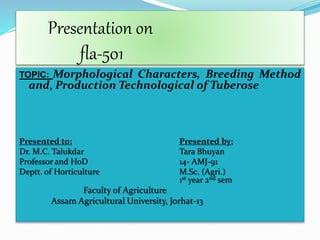
Morphological characters, breeding method and production technology of tuberose
- 1. Presentation on fla-501 TOPIC: Morphological Characters, Breeding Method and, Production Technological of Tuberose Presented to: Presented by: Dr. M.C. Talukdar Tara Bhuyan Professor and HoD 14- AMJ-91 Deptt. of Horticulture M.Sc. (Agri.) 1st year 2nd sem Faculty of Agriculture Assam Agricultural University, Jorhat-13
- 2. INTRODUCTION : Scientific name : Polyathes tuberosa Family : Amaryllidaceae It is native to Mexico and then it spread to different parts of the world Tuberose occupies a very selective and special position among the ornamental bulbous plant for its beauty , elegance and sweet pleasant fragrance. It has a great economic potential for cut flowers trade and essential oil industry. Due to their great demand, it is currently cultivated in most of the tropical and sub-tropical countries of the world. India has a long tradition of floriculture.
- 3. CULTIVARS and varieties: There are three types of tuberose :- i. Single with one row of corolla segments- varieties are Calcutta Single, Shringar, Prajwal, Mexican single, Rajat Rekha(NBRI, Lucknow) ii. Semi-double bearing flower with 2-3 rows of corolla segment, iii.Double having more than three rows of corolla segment- varieties are Calcutta Double, Suvasini. Vyabhav , Swarna Rekha(NBRI, Lucknow)
- 4. Shringar Suvasini Swarna Rekha Single Mexican Rajat Rekha
- 5. MORPHOLGICAL CHARACTERS Plant : Half – hardy ,bulbous perennial. Bulb : Made up of scales. Roots : adventitious and shallow. Leaves : Long, narrow,linear, grass – like, light green and arise in rosette. Flowers : Funnel shaped perianth and are fragnant, waxy type, single or double borne in spikes. Stamens are 6 in number, anthers dorsifixed in the middle, ovary 3 locular, ovules numerous and fruits are capsule.
- 6. BREEDING Haploid chromosome number ,n = 30 Single cultivars are fertile , 2n=2x=60. Used in perfumery. Double cultivars are also fertile, 2n=2x=50. Used as cut flowers. Methods of breeding: Hybridization : 1st cross involving tuberose was reperted in 1911, as Polyanthes geminiflora x P. tuberosa Mutation breeding: 2 gamma rays induced varieties are developed by NBRI, Lucknow. They are- Single type- Rajat Rekha Double type: Swarna Rekha.
- 7. Production technology CLIMATE: Tuberose grows in mild climate without extremes of high and low temperature even though it can be grown under a wide range of climatic conditions . In , India the commercial cultivation of tuberose is mainly confined in warm humid area with average temperature range from 200 to 350°C Very low temperature and frost also damage the plant and flowers. Tuberose grows well in sunny situation.
- 8. SOIL: Tuberose grows in a wide range of soils. Loam and sandy loam soils having pH range from 6.5 to 7.5 with good aeration and drainage are considered suitable for its cultivation . The soil should be rich in organic matter and retain sufficient moisture for proper growth . FYM and leaf mould in proportion of 2:1:1 should be used.
- 9. PROPAGATION :- Propagated vegetatively by division of bulb. To get virus free material or for a very rapid multiplication , the propagation is done through tissue culture.
- 10. BULB SELECTION: Generally bulbs having diameter 2.0-3.0cm are suitable for planting. SPACING: 25 x 25cm ( flat beds), 15 x 15cm ( HDP ) IRRIGATION:- done at 10- 15 days interval in dry weathers. During summer (april - june) – done at weekly intervals. WEED CONTROL: Manual weeding is more effective if done frequently. MANURES AND FERTILIZERS: FYM – 10-15 tonnes / ha N:P:K- 100: 50: 50kg/ha
- 11. PLANT PROTECTION Botriyis Blight Leaf spot Diseases Caused by Symptom Control Stem rot Sclerotium rolfsii Dropping of leaves. Leaves become yellow and dry up. Removal of infected plant. Spraying of carbendazin or copper oxychloride @ 0.1 % Botrytis spots and blight Botrytis elliptica Infected flowers show dark brown spots and slowly complete inflorescence dries. Spraying of mancozeb @ 0.2 %. Leaf spot Fusarium equiseti Initially water soaked spot develop which later on turned into elliptical or round brown spots. Spraying of mancozeb @ 0.2 % is effective. Flower bud rot Erwinia sp Drying of buds . Application of streptocycline @ 500ppm is effective
- 12. Common pests Pest Symptoms Control Grasshopper Insects feeds on young leaves and flower buds. Spraying of chloropyriphos @ 0.1 % is effective Aphids Feeds on flower bud and growing points. Spray malathion 0.08 % at 10 days interval or spray monocrotophos 0.06%. Thrips Sucks the sap from leaves , flower stalk and flowers and damage the whole plant. Spray rogor or malathion @ 0.08%. Red spider mite Sucks the sap from leaves and yellow streaks appear on the leaves , which spread until it become yellow and distorted. Spraying kelthane 0.08%
- 13. HARVESTING HARVESTING OF FLOWERS: Tuberose is harvested by cutting the spikes from the base for table decoration or the individual flower is picked from the spike for making garlands and other floral ornaments. Picking of flowers should be done in cool hours of the day either in the morning or in the evening. Harvesting of flowers on the previous evening and marketing in the next morning leads to a weight loss of about 40 per cent. The flowers spike for vases should be cut when the first pair of flowers fully open, with a sharp knife and place immediately in water.
- 14. HARVESTING OF BULBS : Harvesting of tuberose bulbs at proper stage of maturity is important for storage of bulbs and their subsequent growth after planting. The bulbs reach maturity when the flowering is over and plant growth ceases, depending on the environmental condition and soil moisture